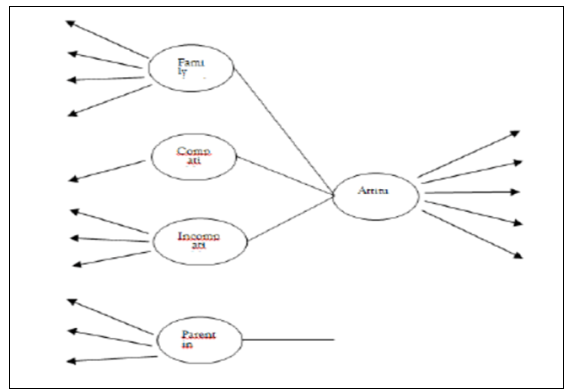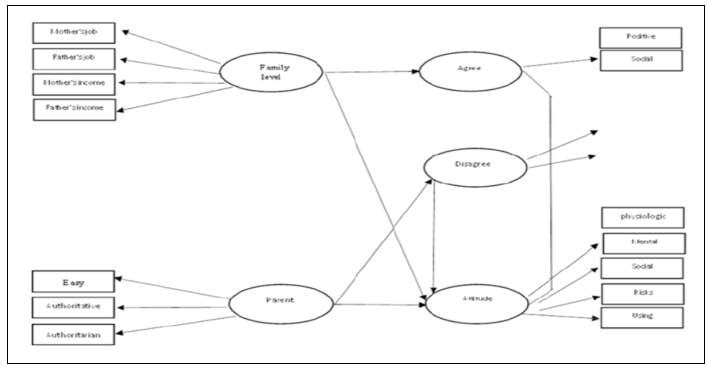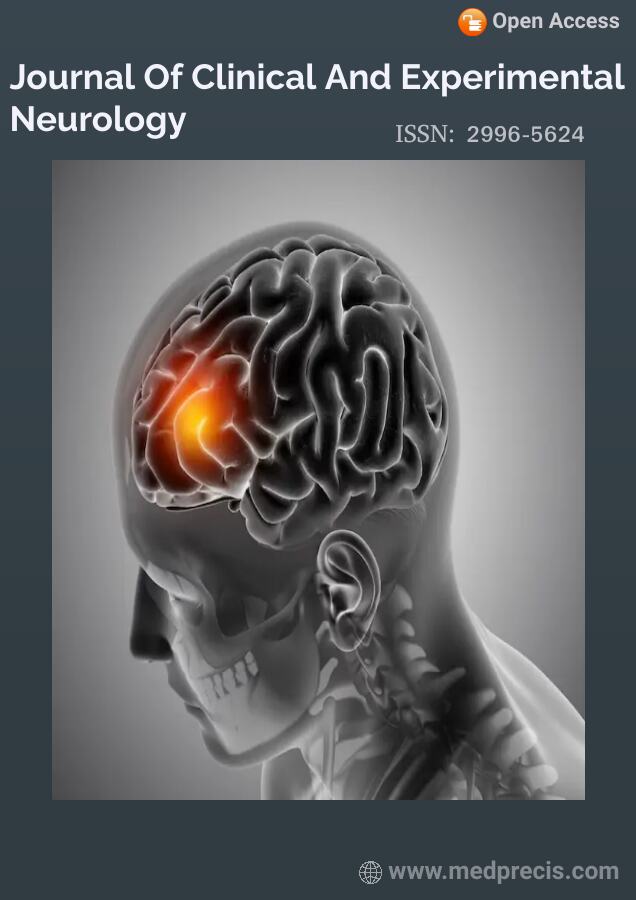Exploring the Links Between Family Risk Factors, Attitudes Toward Substance Use, and the Mediating Influence of Social Problem Solving
Monireh Parsian1*, Somayeh Kamali Eagli2
1Department of Psychology, Adib University, Mazandaran Province, Sari, Iran
2Department of Psychology, Islamic Azad University, Roudehen Branch, Iran
Correspondence to: Monireh Parsian, Department of Psychology, Adib University, Mazandaran Province, Sari, Iran. E-mail: parsian_m@yahoo.com
Received: May 19, 2023; Accepted: June 06, 2023; Published: June 14, 2023
Citation: Parsian M, Eagli SK. Exploring the Links Between Family Risk Factors, Attitudes Toward Substance Use, and the Mediating Influence of Social Problem Solving. J Clin Exp Neurol. 2023;1(1):14-20.
Copyright: © 2023 Parsian M. This is an open-access article distributed under the terms of the Creative Commons Attribution License, which permits unrestricted use, distribution, and reproduction in any medium, provided the original author and source are credited.
ABSTRACT
Introduction: Drug use among adolescents is a critical global concern, warranting multifaceted exploration. While various studies have identified family and individual factors as risks or protective factors against drug use, few have delved into the role of mediators like social problem-solving skills. This study aims to predict adolescent attitudes toward drug use based on family educational risk factors, mediated by social problem-solving skills regarding addiction attitudes, to formulate a comprehensive model explaining drug use tendencies.
Methodology: This descriptive, correlational study involved students across educational levels in Ghaemshahr. A sample of 378 participants was determined using Cochran’s formula. Questionnaires assessing parenting styles, Bamrind parenting styles, addiction attitudes, social problem-solving skills, and socioeconomic status were administered. Path analysis served as the statistical method, with various indicators evaluating model adequacy.
Findings: Family socioeconomic status exhibited a direct, positive, and significant relationship (trajectory coefficient = 2.35) in predicting adolescent attitudes toward drug use. Adaptive problem-solving skills displayed a direct, positive albeit insignificant relationship (path coefficient = 1.63) with drug use attitudes. Conversely, incompatible problem-solving skills showed a direct, significant, and negative relationship (path coefficient = 0.27) with drug use attitudes. Parenting styles demonstrated a direct, negative, and significant relationship (trajectory coefficient = -2.19) in predicting drug use attitudes among adolescents.
Conclusion: Parenting styles, incompatible social problem-solving skills, and attitudes toward addiction significantly relate to adolescent attitudes toward drug use, while drug use itself shows no significant relationship.
Keywords: Attitude; Educational risk factors; Family risk factors; Model design.
INTRODUCTION
Drug use presents a multifaceted challenge that ranks among the most pressing human issues in recent years, profoundly undermining societal foundations. Its prevention demands the application of diverse theories across scientific disciplines and methodological approaches. Research indicates that drug use stems from various factors including family dynamics, social circles, personality traits, and individual predispositions [1].
Adolescent Substance Use: An Overview of Concerns and Influential Factors. The use of substances such as alcohol and tobacco among adolescents aged 12 to 18, particularly in high school environments, is a significant global concern. Middle school emerges as a vulnerable period for the initiation of substance use, signifying the importance of early intervention and prevention strategies. Alarming rates of alcohol and drug experimentation are observed among eighth graders, with approximately 31% reporting alcohol use and 19.6% engaging in drug use, emphasizing the need for targeted preventive measures. Various familial factors, including poor family functioning, inadequate parental supervision, and a lack of family cohesion, along with individual variables like aggression and academic struggles, are identified as risk factors contributing to adolescent substance use. Nearly 30% of teens report engaging in drug experimentation, with school hours serving as a common context for such experiences, emphasizing the role of educational settings in preventive efforts.
Addressing addiction requires a multifaceted approach involving medication, psychotherapy, and rehabilitation, underscoring the crucial role of prevention in mitigating societal costs and protecting future generations. Recent research highlights the influential roles of parenting styles and social problem-solving skills in shaping adolescents' tendencies toward substance use, with family bonding identified as a robust predictor. Studies indicate higher rates of substance use among adolescents from maladaptive families compared to those in mentally healthier family environments, emphasizing the significance of familial influences. Family and social factors play a pivotal role in influencing adolescents' susceptibility to substance addiction, with social problem-solving abilities emerging as critical determinants of substance use tendencies.
Global statistics underscore the widespread impact of drug-related disorders, emphasizing the urgency of addressing this complex issue on a global scale. While existing studies identify family and individual variables as risk factors for substance use, the intricate interplay and mechanisms through which they influence substance use remain unclear, prompting the need for a comprehensive examination. Understanding adolescent attitudes toward substance use requires a holistic exploration of risk and educational factors, alongside social problem-solving skills, culminating in the development of a model that elucidates substance use tendencies [2].
MATERIALS AND METHODS
The study was conducted on high school students in Ghaemshahr during the academic years 1397 and 1398. This descriptive correlational study aimed to explore the relationship between attitudes toward drug use and several key components including family socioeconomic status, adaptive and maladaptive social problem-solving skills, and parenting styles. The statistical population comprised 26,593 adolescent girls and boys in the city, from which 378 participants (193 boys and 185 girls) were selected using stratified random sampling based on educational zones and Cochran’s formula. Participants' ages ranged from 16 to 19 years.
The research instruments consisted of four questionnaires:
a) Attitude Scale with 50 questions assessing attitudes toward the physiological, psychological, and social effects of drugs, dangers of drug use, and interest in drug use.
b) Social Problem-Solving Skills Scale comprising 25 questions measuring adaptive and maladaptive problem-solving styles.
c) Parenting Scales including 30 questions assessing authoritarian, authoritative, and negligent parenting styles.
d) Socioeconomic Status Questionnaire gathering information on personal, educational, occupational characteristics, income, housing, and other factors.
The validity of the instruments was assessed using Cronbach’s alpha method, with validity coefficients ranging from 0.62 to 0.87. Structural equation modeling and LISREL software were employed to analyze the data and evaluate the model's adequacy. Various indicators such as chi-square, normative fit index, goodness fit index, and others were utilized for this purpose.
Findings
- The path analysis revealed significant relationships between attitudes toward drug use and the components under investigation. Specifically:
- Family socioeconomic status exhibited a direct, positive, and significant relationship (t = -2.35, coefficient = 0.15) with attitudes toward drug use.
- Adaptive problem-solving skills demonstrated a direct positive but non-significant relationship (t = 1.62, coefficient = 0.13) with attitudes toward substance use.
- Maladaptive problem-solving skills exhibited a direct, negative, and significant relationship (t = -3.39, coefficient = -0.27) with attitudes toward substance use.
- Parenting styles showed a direct, negative, and significant relationship (t = -2.48, coefficient = -0.19) with attitudes toward substance use.
Overall, the findings indicate a complex interplay between family socioeconomic status, problem-solving skills, parenting styles, and attitudes toward substance use among adolescents, as depicted in Figure 1. Notably, adaptive problem-solving skills were found to be significantly related to family socioeconomic status and parenting styles.

Figure 1: Results of path analysis of the attitude model to drug use in the situation of standard coefficients.
Based on your description, it appears there may be discrepancies between the expected and observed relationships within the model and the coefficients obtained from the analysis. It's crucial to carefully review and analyze the data to ensure the accuracy and coherence of the findings.
In Figure 2, the model of research should ideally reflect meaningful relationships among the components of community problem-solving skills, parenting styles, family socioeconomic status, and attitudes toward drug use. However, if the observed coefficients do not align with expectations, it may indicate potential issues such as measurement errors, sampling biases, or methodological limitations.

Figure 2: The main model of the research in the case of meaningful coefficients (T values).
In Table 1, examining the contribution of each component to attitudes toward drug use in adolescents, it's noteworthy that the component with the highest standard factor load (0.95) has the greatest effect, while the one with the lowest factor load (0.64) has the least effect in explaining attitudes toward drug use. This suggests that certain components may play a more significant role in shaping attitudes toward drug use compared to others.

Table 1: Results of path analysis of the attitude model to drug use in the situation of standard coefficients. Result in the statistical t coefficient of the path dimensions.
Similarly, in Table 2, evaluating the contribution of each component of adaptive problem-solving skills in adolescents, it's essential to consider the implications of the observed coefficients. The findings may shed light on which aspects of problem-solving skills are most influential in adolescents' attitudes and behaviors related to drug use.

Table 2: Status of variables explaining attitudes toward consumption.
To address any discrepancies or inconsistencies in the results, researchers should critically assess the data, validate the measurement tools, and consider potential confounding variables or alternative explanations. It may also be beneficial to conduct further analyses or explore additional variables to gain a comprehensive understanding of the relationships under investigation.
These findings provide insight into the relative importance of different components within adaptive and maladaptive problem-solving skills, family socioeconomic status, and parenting styles. Researchers can use this information to better understand how these factors influence adolescents' attitudes and behaviors, particularly regarding drug use. Further analysis and interpretation of these results may uncover additional insights and implications for future research and intervention strategies.
RESULTS AND DISCUSSION
The primary objective of this study was to forecast adolescents' attitudes toward drug use based on educational and family risk factors while constructing a model to elucidate drug use tendencies among adolescents.
The family's socioeconomic status emerged as a direct and significant predictor of adolescents' attitudes toward drug use, with a standard coefficient of 0.15 and t-value of 2.33. This finding suggests that higher socioeconomic status correlates with more negative attitudes toward drugs, corroborating the results of previous studies by Ghobadipour et al., Hosseini et al., and Seidan et al.
Furthermore, the analysis reveals that while adaptive problem-solving skills positively predict drug use attitudes among adolescents (standard coefficient 0.13, F=1.62), the relationship is not statistically significant. This implies that enhanced social adaptive problem-solving skills may contribute to improved attitudes toward drugs among adolescents, aligning with the findings of Levy et al., Barbara et al., and Michelle J. et al.
Interestingly, maladaptive problem-solving skills exhibited a direct, negative, and significant relationship with attitudes toward drug use among adolescents (standard coefficient -0.15, t=2.33). This suggests that addressing maladaptive social problem-solving skills may lead to improved attitudes toward drugs in adolescents, consistent with the conclusions of other researchers.
Moreover, parenting styles were found to be directly, negatively, and significantly associated with attitudes toward substance use among adolescents (standard coefficient -0.19, t=-2.48). Notably, authoritative parenting style emerged as a positive predictor of negative attitudes toward adolescent drug use. This underscores the importance of implementing effective parenting practices to foster healthier attitudes toward drugs in adolescents, consistent with previous findings.
It is evident that the component of attitudes toward the social effects of drug use exhibits the strongest explanatory power for attitudes toward drug use (standard coefficient 0.95, R2=0.90). This underscores the influence of peer groups and social factors in shaping adolescents' attitudes toward drug use, consistent with prior research by Sharon Levy et al., Michelle et al., and Louise et al.
CONCLUSION
The prevalence of drug use presents a significant societal challenge globally, with increasing rates among adolescents and young adults. Research underscores the multifaceted nature of drug use, influenced by individual, environmental, social, and familial factors. Attitudes toward drug use serve as crucial indicators of risk and protective factors, highlighting the importance of modifying attitudes and equipping individuals with problem-solving skills to combat substance abuse.
Efforts to shift attitudes toward addiction from positive to negative, coupled with the provision of essential problem-solving skills, are pivotal in preventing substance abuse among adolescents. By addressing these factors comprehensively, societies can work towards mitigating the detrimental impacts of drug use and fostering healthier communities.
REFERENCES
- Boys A, Farrell M, Taylor C, Marsden J, Goodman R, Brugha T, et al. Psychiatric morbidity and substance use in young people aged 13- 15 years: results from the child and adolescent survey of health. Br J Psych. 2003; 182(6):509.
- Mason WA, Kosterman R, Haggerty KP, Hawkins JD, Redmond C, Spoth RL, et al. Gender moderation and social developmental mediation of the effect of a family-focused substance use preventive intervention on young adult alcohol abuse. Addict Behav. 2009; 34(6-7):599-605.
- Horton EG. Racial differences in the effects of age of onset on alcohol consumption and development of alcohol-related problems among males from mid-adolescence to young adulthood. J Ethni Subst Abuse. 2007; 6(1):1-13.
- Johnston LD, Malley PM, Bachman JG, Shulenberg Ge. Monitoring the future: National results on adolescent drug use: overview of key findings. Epidemiol Rev. 2010; 2:4-13.
- The national center for drug abuse statistics. 2017: 6.
- Substance abuse and mental health service administration. Key substance use and mental health indicators in the United States: result from the2017 national survey on drug use and health. 2018.
- Substance use and abuse in adolescent; sharlon lovy, md, mph, harvard medical school. Last full review. 2019.
- Lorence B, Hidalgo V, Pérez-Padilla J, Menéndez S. The role of parentung styles on behaivier problem profiles of adolescent. Int J Environ Res Public Health. 2019; 16(5):2767.
- Schlauch RC, Levitt A, Connell CM, Kaufman JS. The moderating effect of family involvement on substance use risk factors in addescents with server emotional and behavioral challenges. Content lists available at science Direct. 2013; 38(7):2333-2342.
- Cleveland MJ, Greenberg MT, Feinberg ME. Protective families in high and low risk environment: implications for adolescent substance use. J Yonth Adolescene. 2010;39(2):114-126
- United Nations office on Drugs and crime; 6 June (UNODS)+2019.
- Mir L, Arbabi M, Miri M, Miri M. A study of socio-economic-cultural factors affecting drug addiction among students of Islamic Azad University, Iranshahr Branch. 2017.
- Investigating the role of individual, family, social and economic factors in the tendency of addiction in women in niko akram, Ghorbani Alireza, Mohammadi Niko, Azam. 1397.
- Investigating the relationship between addiction tendency and critical thinking and problem solving skills among the youth of Kermanshah Hosseini Seyed Ali, Ghobadi Samaneh. 2016.

